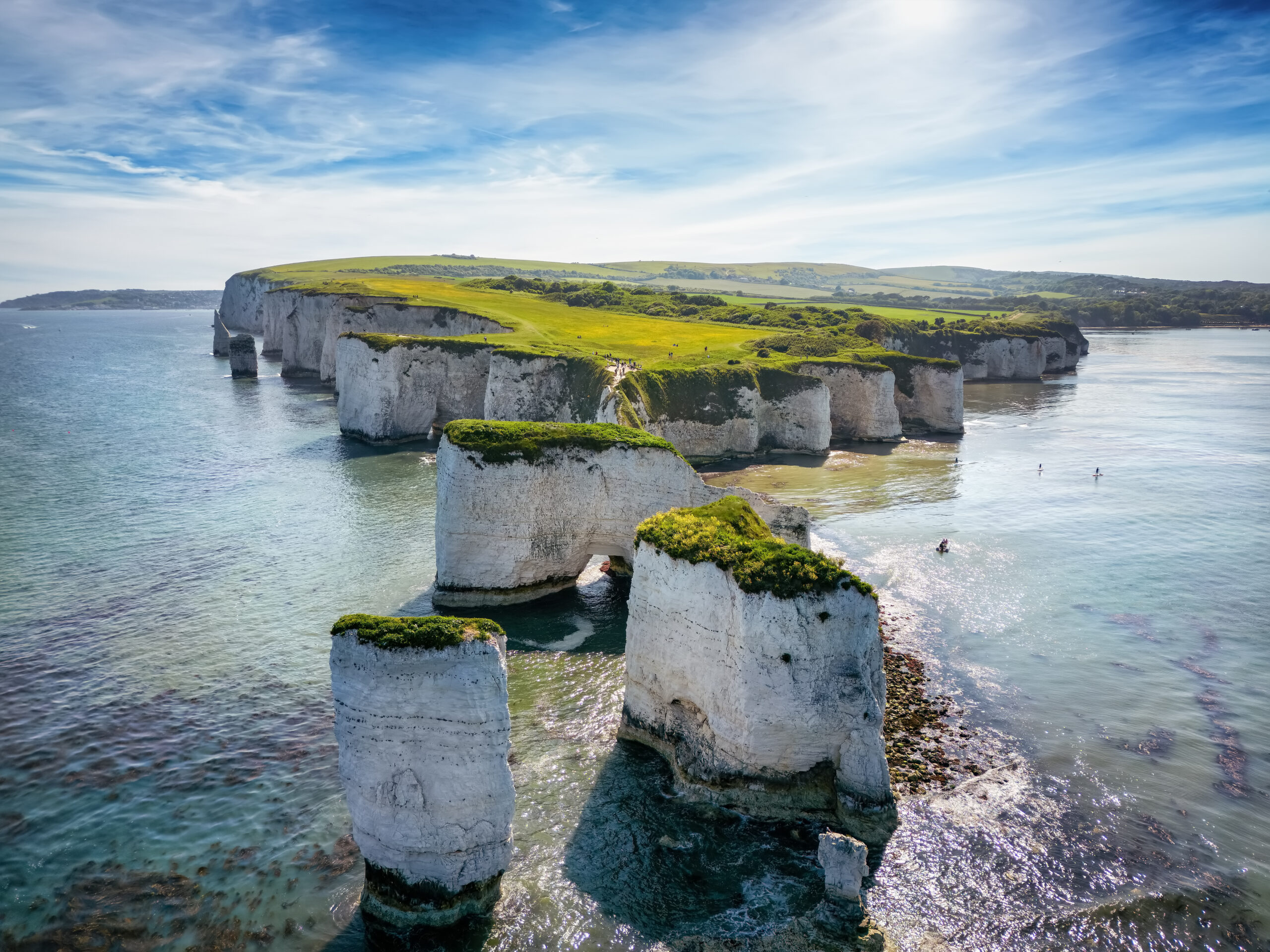Shaftesbury
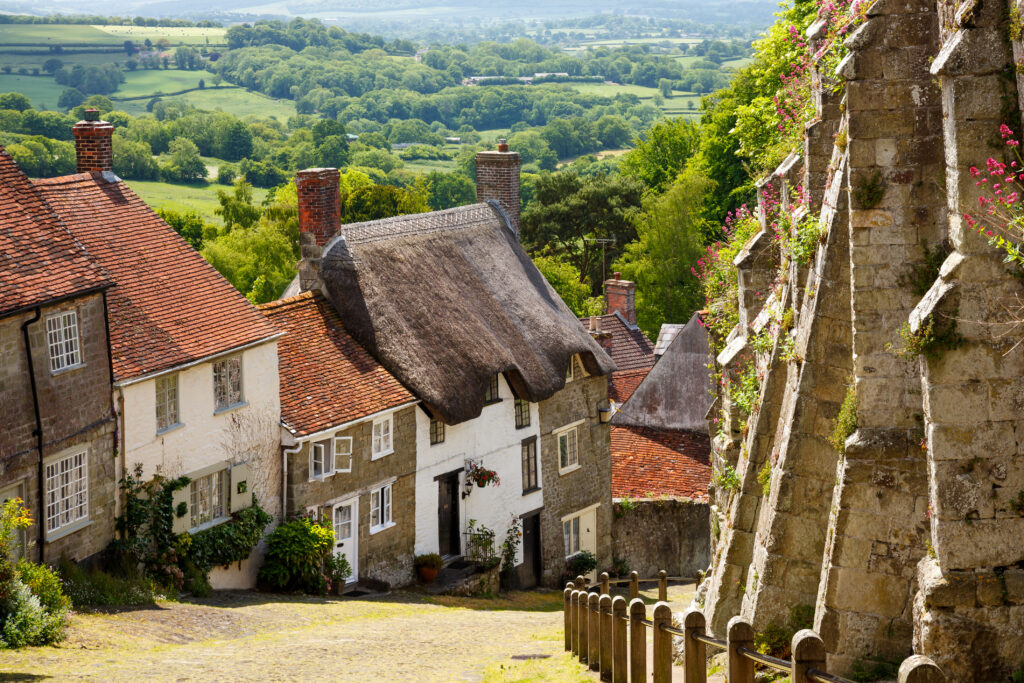
Shaftesbury, with a population of just under 6,700, used to be called Edwardstowe until the town’s name was changed following the Reformation.
It is situated on a small hill and from the right places there are beautiful views of the surrounding hills of northern Dorset. Glastonbury Tor and the Isle of Purbeck peninsula on the English Channel, for example, are visible from here
Shaftesbury’s history goes back to the Anglo-Saxons of the 9th century, when a fort and an abbey were founded there by King Alfred the Great in 888.
The town has had mayoral rights since 1313, and in the historic town hall you can not only see the names of all the “First Citizens” from 1313 to the present day, but also their portraits since 1891 in a picture gallery.
However, Shaftesbury is really famous for its “Gold Hill” from Anglo-Saxon times. It is a narrow, very steep street with buildings on one side only. On the other side is a high wall to support the slope. It can be reached directly from the High Street above.
Shaftesbury is also known as the “Gateway to the South West of England”; from there it is not far to the prehistoric “Stonehenge”, to the cities of Bath and Bristol in the north or Bournemouth and the so-called ‘Jurassic Coast’ in the south.
Bournemouth
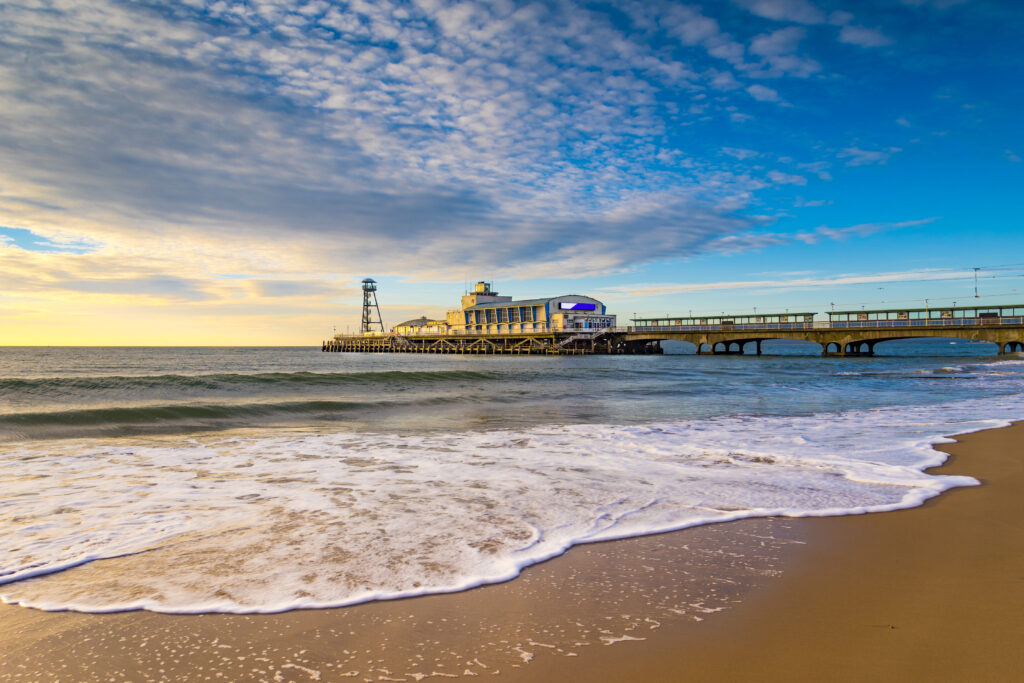
Bournemouth on the Dorset coast has been a popular seaside resort since the 19th century – with more than 11km of golden beaches and some of the warmest sea temperatures in the UK, it’s a great place for seaside vacations.
As well as its glorious beaches, Bournemouth is renowned for its gardens; over 800 acres of gardens are waiting to be explored all year round. The gardens are divided into three sections, Lower Gardens, Middle Gardens and Upper Gardens.
The Lower Gardens are just a 5 minute walk from the main shopping area, the beach and the pier. The Lower Gardens are known for their flower beds that bloom during the summer months; there is a bandstand for concerts and an aviary.
The Middle Gardens were first developed in the 1870s and feature tennis courts, a children’s playground, a war memorial, rose gardens and a rhododendron walk.
The Upper Gardens were designed as a private family garden in the 1860s; they have numerous unusual tree species, including what is said to be the largest North American giant redwood tree in the country.Most of the trees are over 100 years old and were planted in the last part of the 19th century. There is a Victorian Gothic-style water tower that supplied the water for the fountains.There are wooden walkways throughout the garden, making it easy for visitors to explore the garden.
Bournemouth Pier was originally opened in 1880; it is 305m long and is an essential part of any visit to Bournemouth. There was once a theater at the end of the pier, but it is now Rock Reef, a covered climbing center that also has the world’s first pier to shore zip-wire.
Hengistbury Head
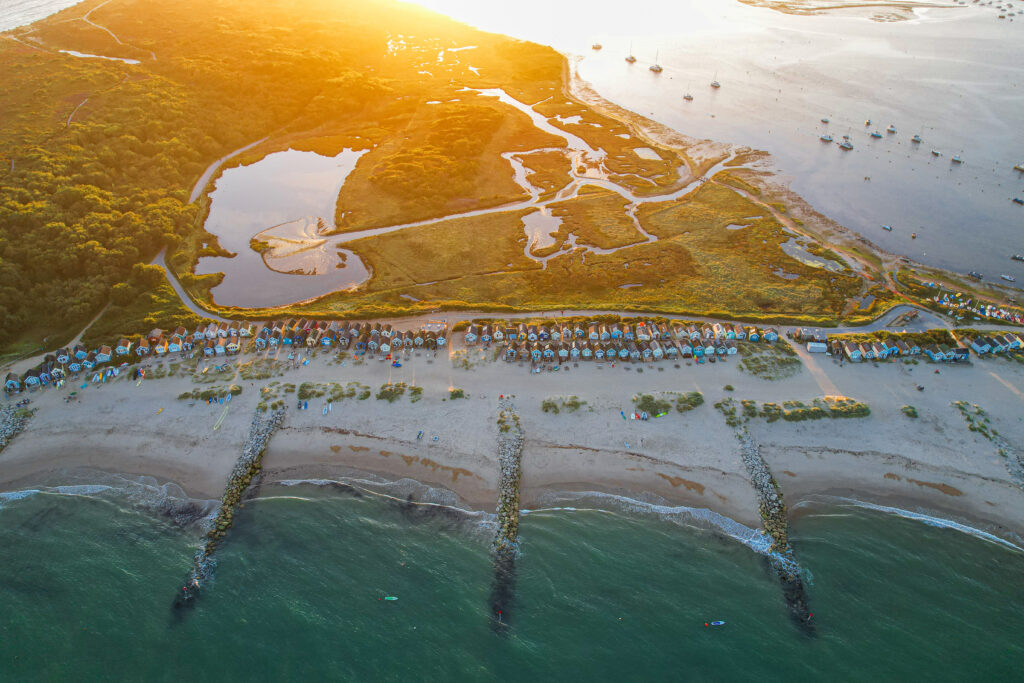
Hengistbury Head is a picturesque headland jutting out into the English Channel. It is made up of idyllic stretches of land with heathland and green spaces, freshwater wetlands and rugged coastlines. Take the opportunity to take a leisurely stroll and let yourself be captivated by the impressive region and its eventful history.
Stroll along coastal paths with a view of the sea and capture the sensational maritime backdrop and the romantic play of colors at sunset with your camera. You can also climb Warren Hill, the higher part of Hengistbury Head. From here you have a great view of the idyllic landscape with its diverse flora and fauna. The region also boasts architectural gems, such as evidence from the Bronze Age, the Iron Age and the period of Roman occupation.
Hengistbury Head is home to 500 different plant species and 300 different bird species. If you have binoculars and a camera with you, you will be rewarded with wonderful close-ups and enlargements.
The headland is characterized by its impressive landscape and historical flair, which can be traced back to evidence from the younger Palaeolithic period. The climate of this region is characterized by warm, sunny summers and cold winters with occasional snow flurries.
Mudeford
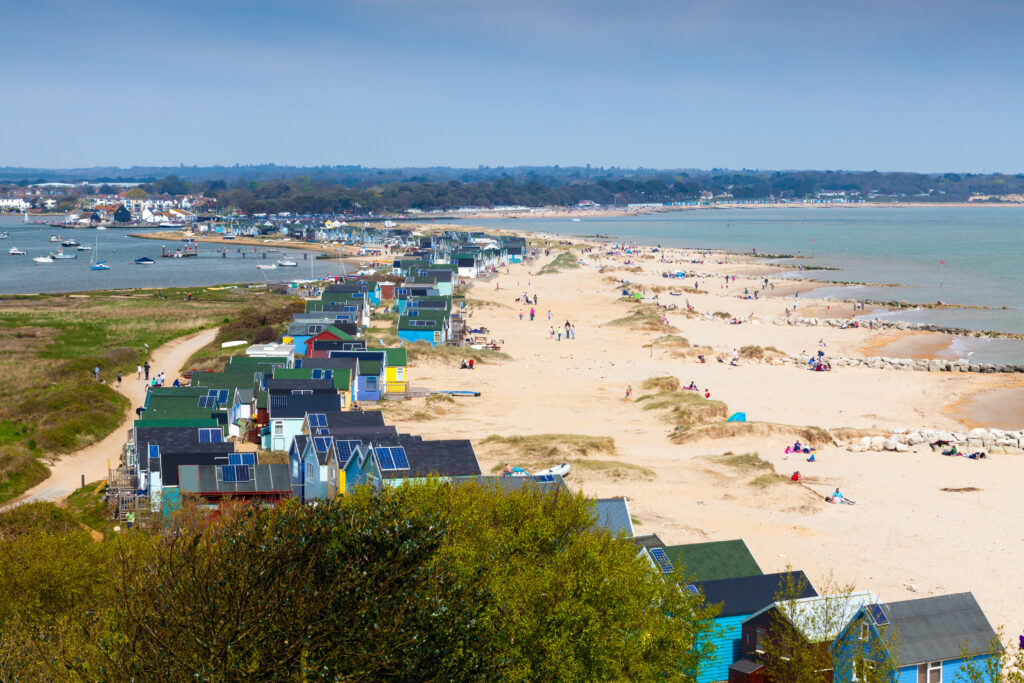
Mudeford may be small, but it has it all!
Christchurch Harbour on one side and the open sea on the other make this a very popular destination for sailors, windsurfers and beach lovers in general. Mudeford is an impressive village with two sides, partly on a sandbank, while the rest, including Mudeford Quay , is on the other side of a water channel on the ‘mainland’.
Located on Christchurch Harbour, Mudeford is perfect for water sports and beach life thanks to its incredible coastal location. Mudeford Spit has a friendly, family-oriented community that swells in numbers during peak season, but without losing its innate charm. The beach huts here are some of the most sought-after and expensive in the country, and no wonder. Overnight stays are permitted and what an incredible view to wake up to!
Many day visitors reach Mudeford Spit via Hengistbury Head , where there is a café and visitor center. After parking, it’s a pleasant walk along a tree-lined path suitable for both cyclists and pedestrians. For the weary or the young, there is also the seasonal train that runs regularly from the Hiker Café to Spit beach.
Alternatively, pedestrians and cyclists can take a small ferry from Mudeford Quay to Mudeford Spit – a short but adventurous journey as this stretch of water is subject to tides and currents.
Christchurch
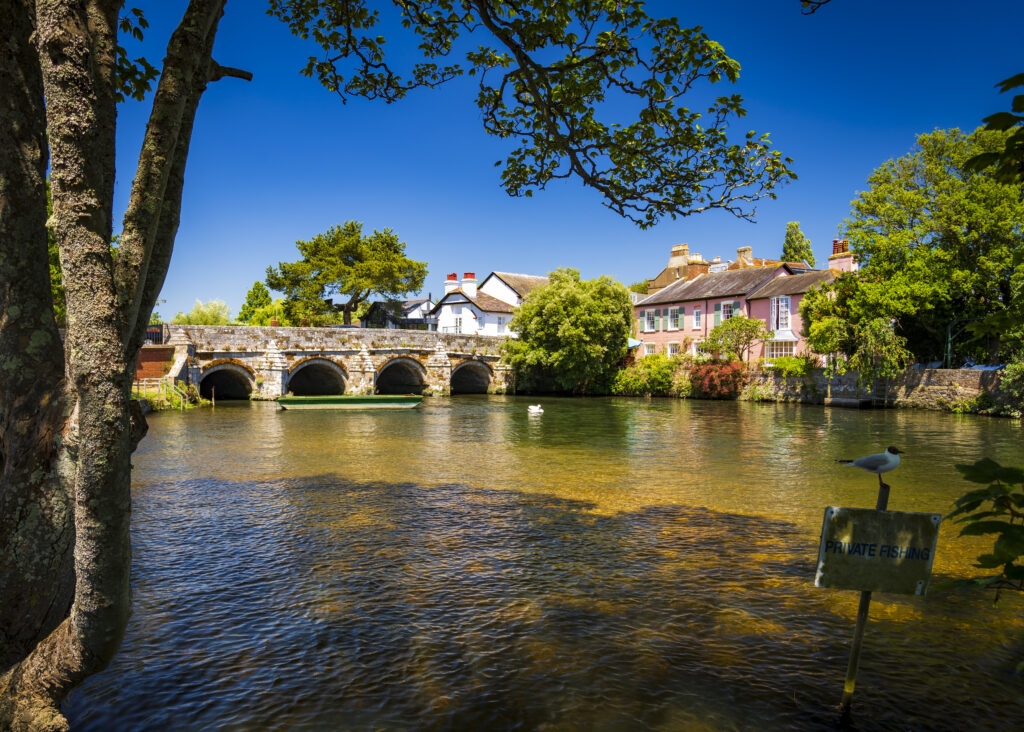
Christchurch lies at the junction of the Avon and Stour rivers; its natural harbor is a stunning place for visitors. The harbor offers boat trips around the bay and passenger ferries to Mudeford during the summer. At low tide the harbor becomes a mud bank, attracting large numbers of migratory birds, and the north side of the harbor is a nature reserve.
The name Christchurch comes from the monastery church. Begun in the 11th century, its construction took four centuries to complete. At 91.4m, it is Britain’s longest parish church and the 36.5m high tower has two of the oldest bells in the country, which were cast in 1370.
Next to the monastery are the picturesque ruins of the Norman castle and Norman house, which is one of the few surviving examples of Norman domestic architecture in England. From here, follow the shady cloister path beside the peaceful old mill stream to the town quay, a charming setting where meadows and gardens meet slow-moving water, dotted with small boats, ducks and swans.
On the quay you will also find Place Mill, an Anglo-Saxon watermill that has been carefully restored and is now an art gallery.
Poole
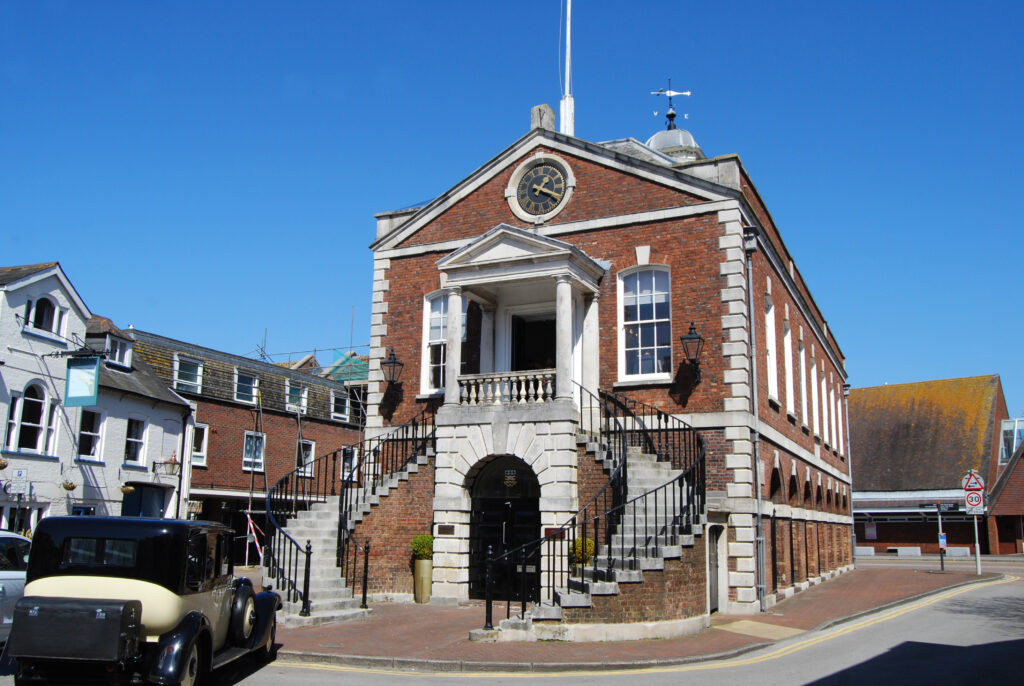
Poole, a jewel on the south coast of England, has a rich history dating back to the Iron Age. In the Middle Ages, the town gained importance as a trading center for wool and cloth, and the natural harbor, the second largest in Europe, played a crucial role in the burgeoning trade with North America and the Mediterranean.
The ceramics industry in particular shaped Poole in the 17th and 18th centuries. The historical heritage can still be felt today in the narrow streets of the old town and the imposing merchants’ houses.
Culturally, Poole offers a vibrant arts scene. Inspired by its maritime past and the natural beauty of the harbor town, creativity and artistic creation are deeply rooted.Museums such as Poole Museum and Scaplen’s Court Museum invite visitors to explore local history.
The Lighthouse, Poole’s center for the arts, offers a diverse program of theatrical performances, concerts and visual arts, reflecting Poole’s vibrant cultural heart.Poole is known for its natural charm and diverse architecture, ranging from historic buildings to modern constructions.
At the heart of the town lies Europe’s second largest natural harbor, considered an ecological wonderland where a variety of water sports and outdoor activities captivate visitors. Surrounded by stunning coastal scenery and the picturesque island of Brownsea, Poole offers a unique contrast between natural beauty and urban living.
Corfe Castle
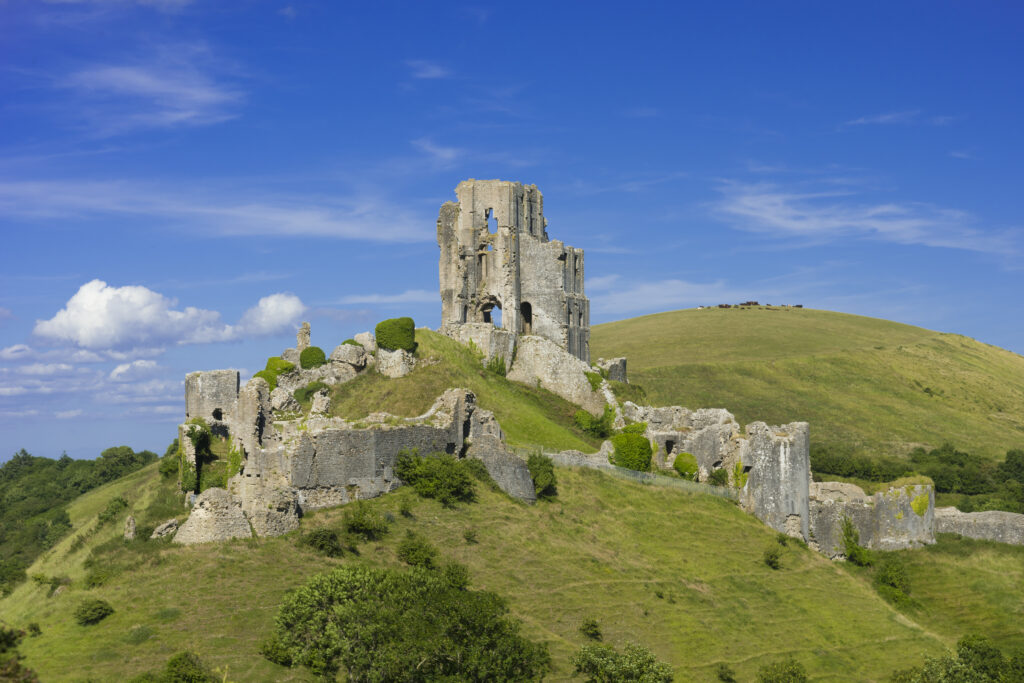
The ruins of Corfe Castle tower romantically over the small southern English town of Corfe. It takes a lot of imagination to imagine what the castle once looked like when it was built in the 9th century by Alfred the Great as protection against the invading Danes.
Since those years, Corfe Castle has seen and experienced an incredible amount and the ravages of time have persistently gnawed away at the castle walls. In 987, Edward the Martyr was murdered in the shadow of the castle in Corfe’s market square and his body thrown into the well.
He was succeeded on the throne by Aethelred the Unready, who owes his name to the fact that he was only 3 years old at the time.
The Danes invaded the country plundering and robbing, leaving little of the original Corfe Castle.
The Norman conquerors took over the castle again almost 100 years later: A new limestone castle was built on the site of the old fortifications. It is its ruins that we can admire today on the hill above Corfe.
Corfe Castle rises out of the mists of the past into our time.
Baldwin de Redvers managed to hold the castle until the end and defend it against Stephen’s troops. Corfe Castle then saw quieter times and served as a royal residence and royal treasure house between the 13th and 16th centuries.
Incidentally, it is not only Corfe Castle itself that is worth a visit: the medieval village of Corfe and the 13th century church tower are also worth a visit.
Old Harry Rocks
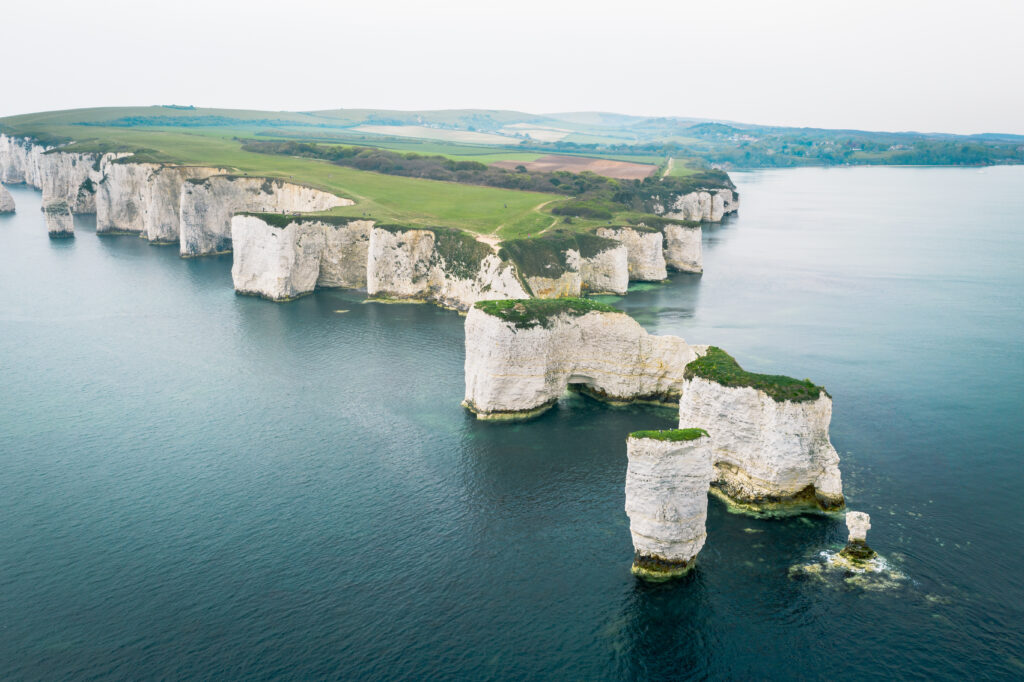
If you want to see the chalk rock formation, you have to travel to the far south of England. There, the two rock needles stand in the water off the Isle of Purbeck peninsula on the coast of the county of Dorset. The peninsula is located around 10 kilometers south of the town of Bournemouth. The best starting point for a hike is the small village of Studland, which has three beautiful beaches in addition to the famous rock formation.
Here, where the Jurassic Coast comes to an end, the two chalk cliffs stand defiantly in the waves of the English Channel. Surrounded by wild willows, bird breeding grounds and, depending on the weather, foaming waves, Old Harry Rocks seem a little like the end of the world, which they mark in a shimmering white. Relics from the Bronze Age and Celtic farmers have been found here, as well as smuggled pirate goods. According to legend, the two chalk rock needles are named after a local pirate and his wife.
The smuggler Harry Paye is said to have been up to mischief here at the beginning of the 15th century. An approximately 5-kilometre circular path from and to Studland leads across lush green fields to the rock formation.
If you look closely, you can still see the historic stone walls of the Celtic farmers. Peregrine falcons and the largest bird species in the gull family – the great black-backed gull – circle over the heads of hikers for most of the year, as they have a hunting and breeding ground here.
Jurassic Coast
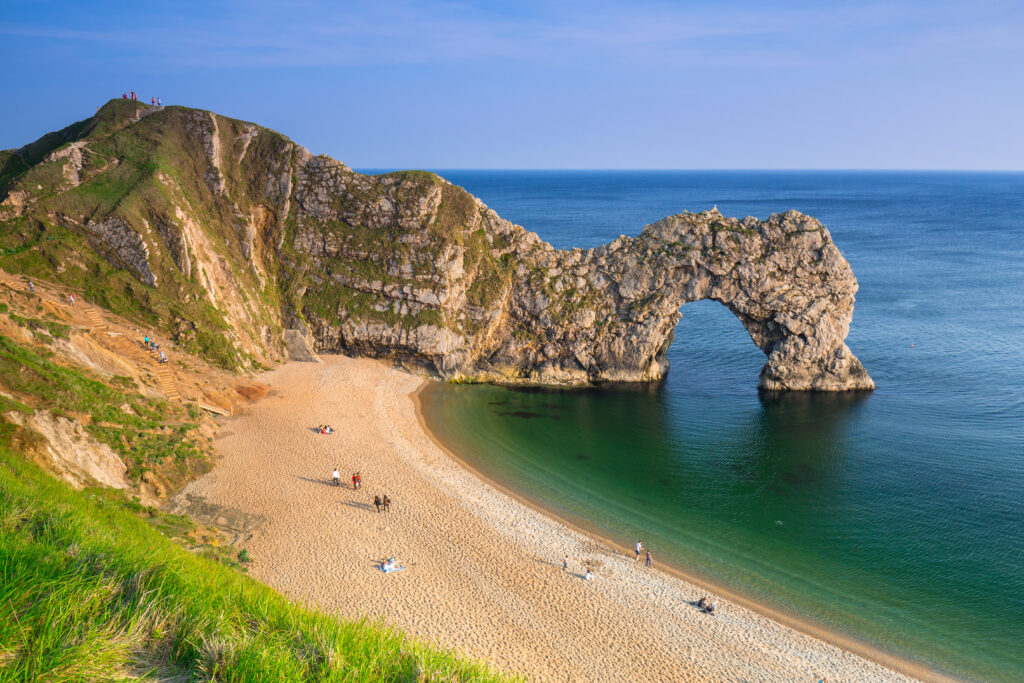
The 150 km long “Jurassic Coast” begins at Orcombe Point near Exmouth in the county of Devon and stretches all the way to the three chalk pillars “Old Harry Rocks” on the Isle of Purbeck. This section of coastline was added to the UNESCO World Heritage List in 2001 due to its special nature.
The name “Jurassic” automatically makes you think of a dinosaur park. However, the name is actually derived from the geological finds from the Triassic, Jurassic and Cretaceous geological systems, which trace the history of this stretch of coastline, and therefore the history of the earth, back 185 million years.
For hiking enthusiasts, the South West Coast Path along the Jurassic Coast offers spectacular views of the primeval beauty of this landscape.
There are also numerous geological features to discover along the way. The red cliffs of the village of Budleigh Salterton in East Devon, for example, are particularly worth seeing.Here, the sea takes on a reddish hue when the waves are strong due to the sediment being washed out. Lulworth is home to unique rock formations such as the Durdle Door and a famous fossil forest that can only be seen at low tide.
Amateur archaeologists will also get their money’s worth here, as you can search for fossils yourself in many places. The only requirement: do not use a hammer and leave large fossils where you find them. The best chances of finding them are on the beaches of Lyme Regis.
Isle of Portland
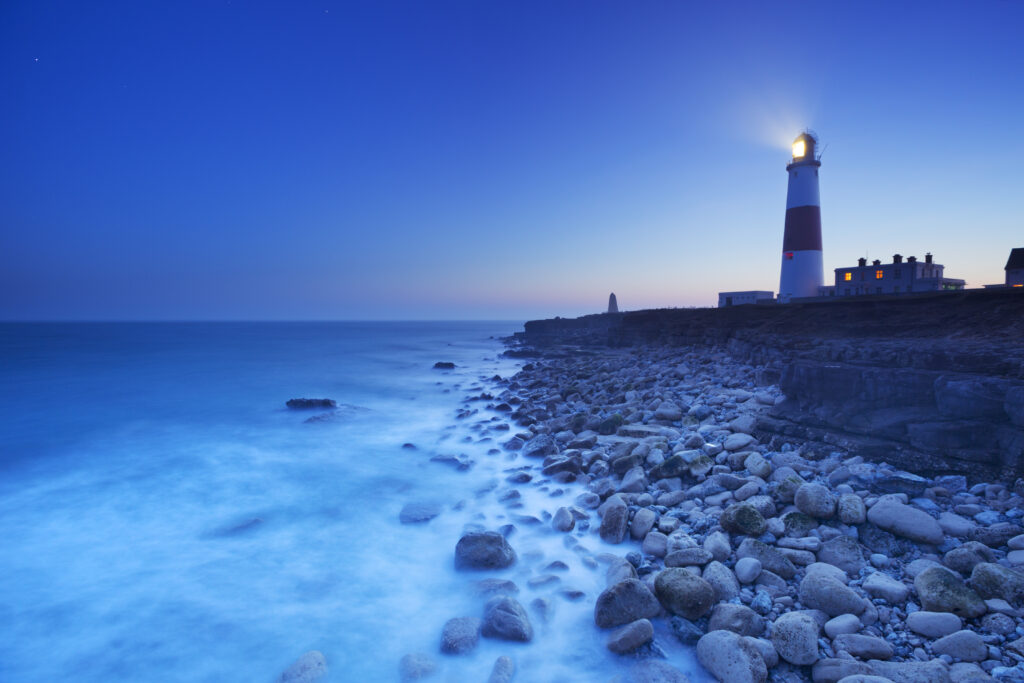
The Isle of Portland is actually only a peninsula, as it is connected to the mainland by a thin land bridge called Chesil Beach. The 6.4 km long and 2.4 km wide limestone rock is located near Weymouth in the English Channel.
The peninsula was already inhabited in the Mesolithic period, as archaeological excavations have shown. The site at Culverwell with its 8500-year-old finds can be visited today. Romans and Vikings, who invaded England for the first time, also left their mark here. In 1539, Portland Castle was built on the orders of King Henry VII as a defense against the French. Today it is one of the best-preserved castles from this period.
Today, just over 12,000 people live on the Isle of Portland. The white Portland Stone comes from the peninsula and has been used for buildings since the 17th century. These include monuments such as St. Paul’s Cathedral in London and the UN headquarters in New York. After the devastating Great Fire of London in 1666, six million tons of the stones were imported into the city to rebuild it.
The Portland Museum informs visitors about the everyday life of the island’s inhabitants since the Mesolithic period, stone mining on the peninsula, its maritime history and the fossils found there. Other attractions on the Isle of Portland include the imposing lighthouse, which was built in 1906 to guide ships through the English Channel and from which you can enjoy an impressive view of the sea.
Weymouth
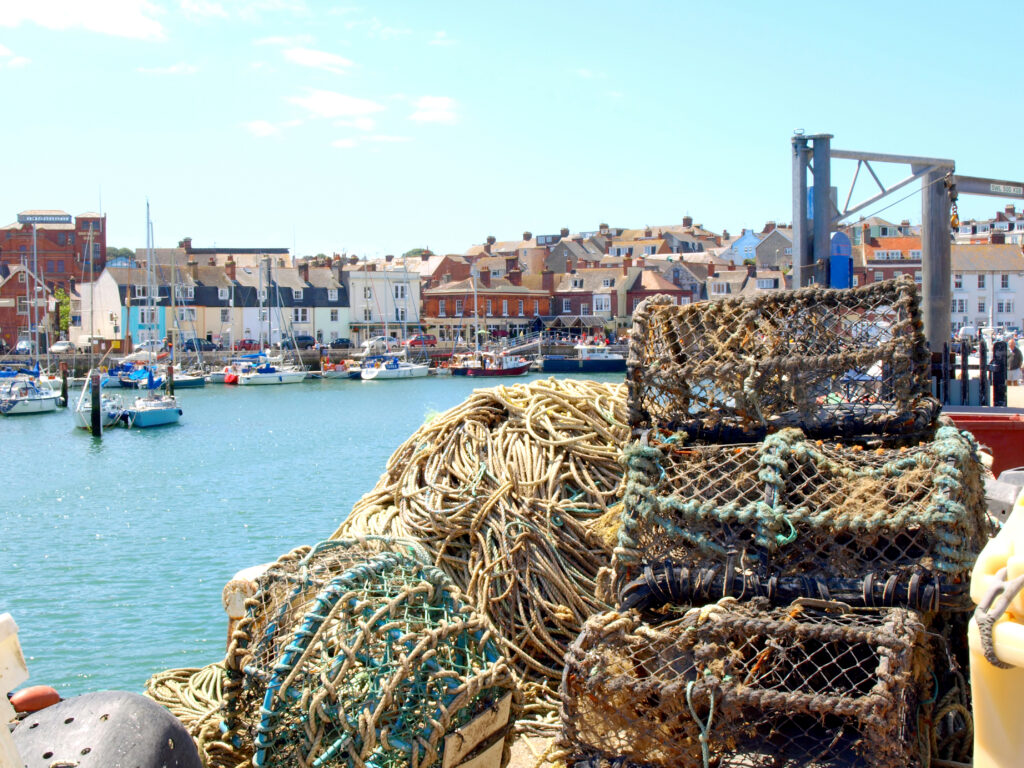
Weymouth is a classic English seaside resort in Dorset with a long golden sandy beach and promenade. King George III visited in 1798 and became the first monarch to use a bathing machine. He visited the town frequently and Weymouth became a fashionable seaside resort. A statue of George III stands on the promenade; it was erected in 1810 to commemorate his golden jubilee. The view from the bay, along the Jurassic Coast, is spectacular. In 2012, Weymouth hosted the sailing events during the London Olympic and Paralympic Games; the seafront with its Georgian buildings provided a magnificent backdrop. To the west of the beach is the narrow picturesque harbor with small fishing boats unloading their catch at the quay.
The Jurassic Skyline in Weymouth offers you the most fantastic view over the Jurassic Coast. 53 meters high and rotating 360 degrees, this viewing pod offers panoramic views up to 26km across the English Channel and towards Lulworth and Portland. The Skyline is open daily.
No vacation in Weymouth would be complete without a visit to Chesil Beach. The Old English word ‘chesil’ means pebble. This strange natural phenomenon is no ordinary pebble beach, rather it is a 27.3km long pebble embankment, up to 10.7m high and 137-183m wide and includes the Fleet Lagoon. Chesil Beach with its 180 trillion pebbles and the lagoon are both a site of special scientific interest. The best views of the beach are from either Abbotsbury or Portland.
Kingston Lacy
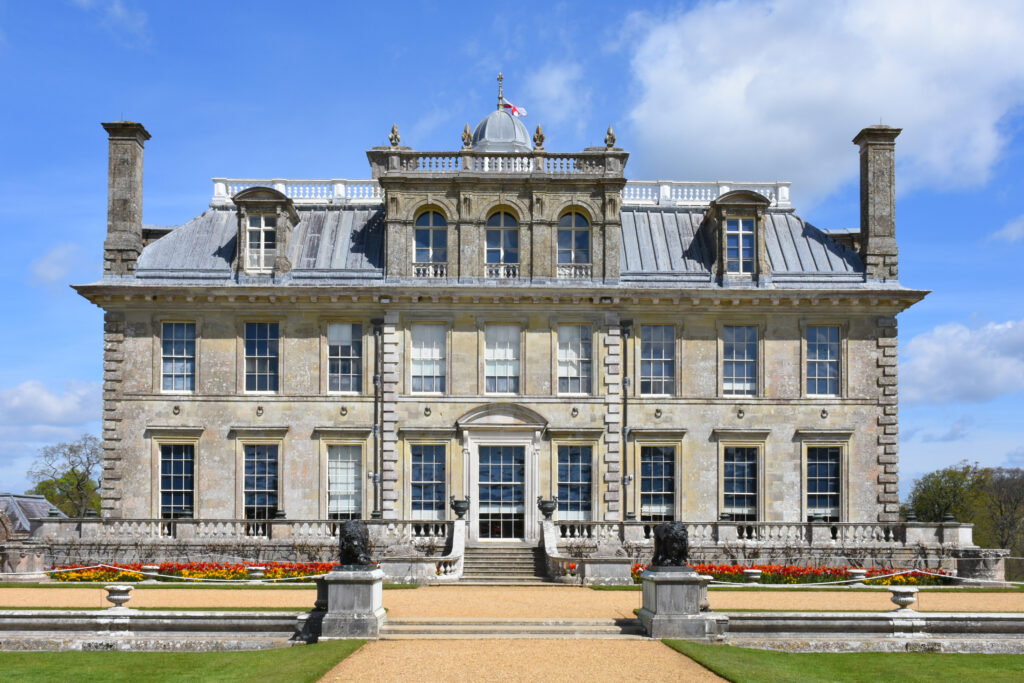
To the north of Poole, in Wimborne Minster to be precise, is Kingston Lacey, which is under the auspices of the National Trust. The estate was built in the 1660s in the then typical Carolean style for Sir Ralph Bankes, whose headquarters Corfe Castle was completely destroyed during the previous English Civil War.
In the first half of the 19th century, Sir Charles Barry Kingston gave Lacy its current appearance in the style of a Venetian palace. The interiors are correspondingly lavishly decorated. One example of this is the spectacular Spanish Hall with its Venetian ceiling from the early 17th century, gilded leather wall hangings and oak and cedar paneling. Barry was a rising star in the Victorian architectural firmament and his work includes the Houses of Parliament in London and the remodeling of Highclere Castle.
Above all, however, Kingston Lacey is known for his art collection. In addition to works by Rubens, van Dyck, Titian, Tintoretto and Brueghel the Younger, there is also England’s largest private collection of Egyptian antiquities to discover. The magnificent family library contains over 1,450 books dating from before 1801, including a magnificent Jean de Planche binding for Sir Nicholas Bacon, probably one of the National Trust’s most important books.
The 17th century formal garden, a Japanese garden with an authentic tea house and the surrounding woodlands invite you to take long walks after your tour of the house.
Lyme Regis
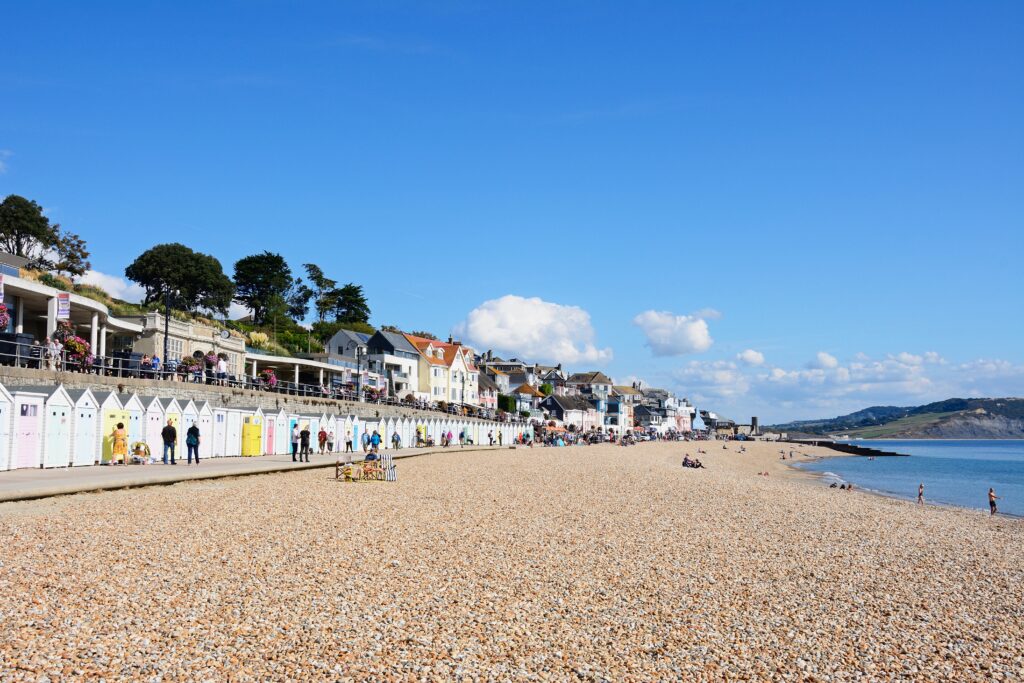
The charming little town of Lyme Regis has a population of less than 4,500. Lyme Regis is located around 90 km west of Bournemouth and around 50 km from Exeter, directly on the English Channel. The imposing harbor complex of Lyme Regis is called “The Cobb”. It was built in the 14th century and is now a landmark of the town. In winter, the harbor wall protects the port of Lyme Regis from storms and bad weather. In summer, however, it can be used for wonderful walks, as it offers a fabulous view of Lyme Regis Bay and, of course, the English Channel. The port of Lyme Regis was already one of the most important ports in the country in the 13th century. The Parade, the street by the harbor, with its numerous cafés and restaurants, is a destination not only for locals but also for many tourists. From the harbor, the small streets and alleyways of the town stretch up the hillside and look down on the harbor and the sea from high above.
In the western part of the town, the Langmoor and Lister Gardens also offer excellent views down to the harbor. There are wonderful walks along the River Lym, including to the Town Mill, a watermill and the Ship Inn.
Numerous fossils have been found around and in Lyme Regis, which are still being uncovered by landslides today, making the area an ideal place for (amateur) palaeontologists. Numerous walks in the footsteps of fossils are also organized by the Lyme Regis Museum.
Dorchester

Dorchester is the historic county town of Dorset and ‘Casterbridge’ in Thomas Hardy’s novels. Dorchester’s history dates back to Roman times, and the remains of the Roman town wall can still be seen, along with a Roman town house. Dorchester’s history also has a darker side; including the conviction and deportation of the Tolpuddle Martyrs in 1834 for forming a trade union, and the infamous Judge Jeffreys also stayed in the town while conducting the ‘Bloody Judgment Days’ in 1685.
Hardys Cottage is located at Higher Bockhampton, 4.8km north east of Dorchester. Thomas Hardy was born in this small thatched cottage in 1840 and grew up here. He also wrote his early novels here. The garden is a typical cottage garden and inside the house you will discover what life was like in a 19th century country cottage.
Maiden Castle is not really a castle; it is one of the finest and most complex Iron Age hill forts in Britain. It was built in the first century BC to protect hundreds of local residents from attackers. The hill fort could not withstand the Roman legions that attacked in 43AD. The fortress was abandoned and a temple was built here in the 4th century. Maiden Castle is open all year round, and the best time of day to visit is early morning or early evening light, when the shadows highlight the rings.
Wareham
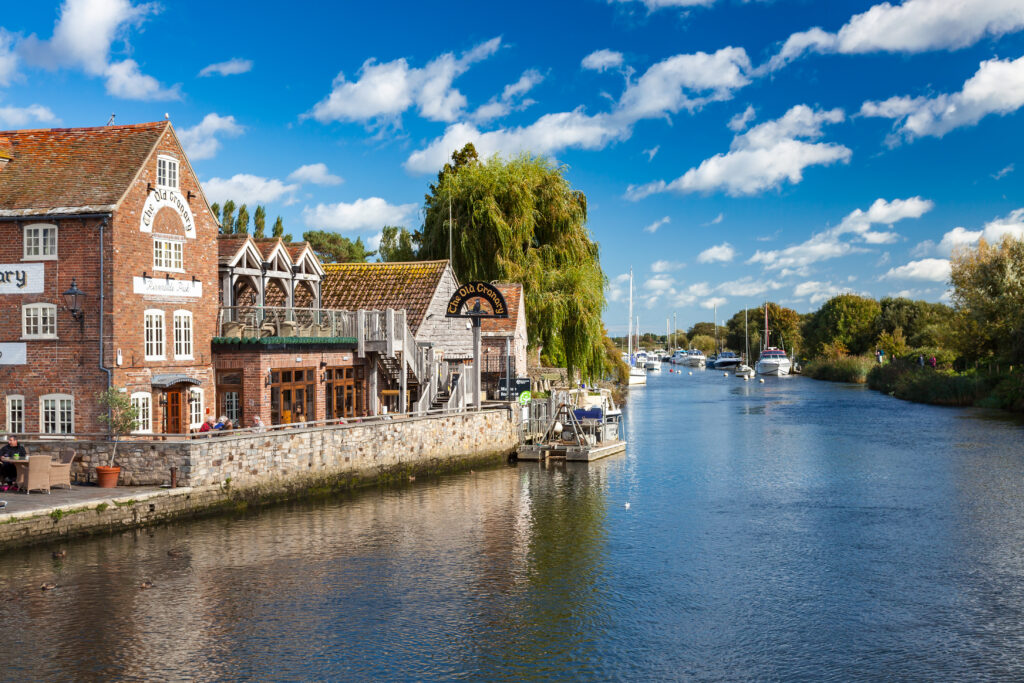
Wareham on the River Frome in Dorset is a picturesque market town with a fascinating history dating back almost 2000 years. The town flourished in Saxon times and was an important fortress for King Alfred the Great. The old Saxon town walls are a delight to walk around and one of the highlights is the Saxon church of St Martins, which houses early medieval paintings and an impressive monument dedicated to T. E. Lawrence (Lawrence of Arabia).
Wareham’s quay appears in many photographs. This picture-perfect spot was once the arrival point for large sailing ships from all over the world, but now you can just sit and relax here, hire a boat or go down the river in a pedalo. Next to Warehams quay is the Discover Purbeck information center, where you can find out lots of details about the area, including walking and cycling routes.
Clouds Hill is an isolated forester’s cottage in the countryside near Wareham. This tiny cottage was once the home of T. E. Lawrence (Lawrence of Arabia) and is now a museum owned by the National Trust. It is almost exactly as he left it when he died here in 1935.
Sherborne
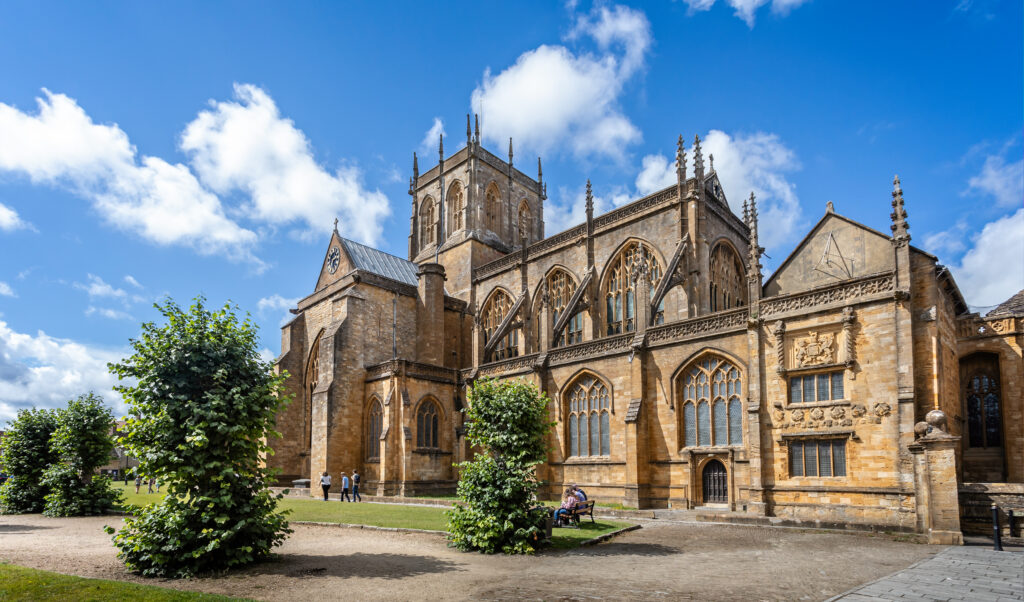
Sherborne, nestled in green valleys and wooded hills, is undoubtedly one of England’s most beautiful towns. This medieval gem in Dorset is known for its art, antiques and world-famous schools.
Sample the best local produce at the Saturday farmers’ market, browse for an antique bargain at the regular vintage market or enjoy a guided walk around this pretty town. A visit to Sherborne is an absolute must!
The many old and beautiful buildings, the magnificent abbey, the picturesque Almshouse and the two castles (one of which was built by Sir Walter Raleigh) make Sherborne a captivating destination.
With a wide selection of individual stores and boutiques, Sherborne is a great place to find unique gifts, home inspiration and exclusive fashion. The town is also a treasure trove for antique lovers..
There are plenty of events in Sherborne throughout the year to keep you entertained. Classical music lovers can be serenaded at one of the many concerts and performances at Sherborne Abbey, with the spectacular setting adding to the magical atmosphere.
The annual Sherborne International Film Festival is not to be missed.

